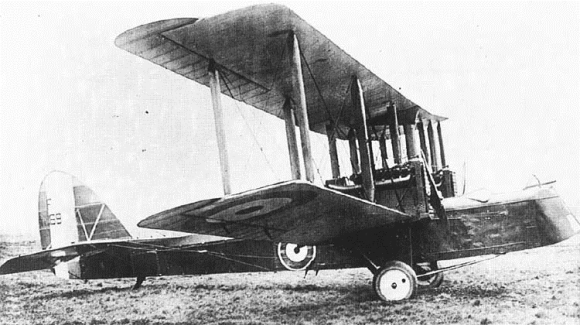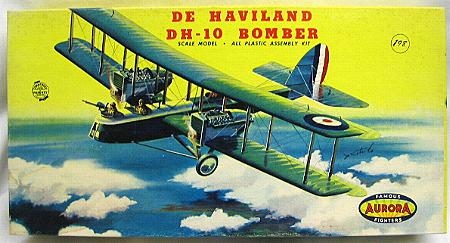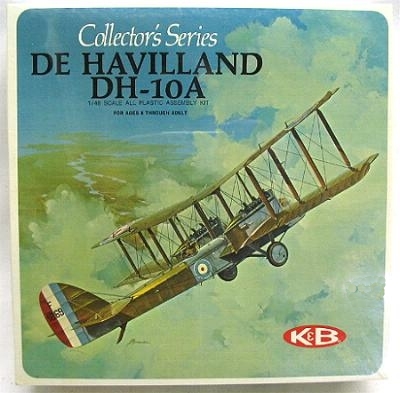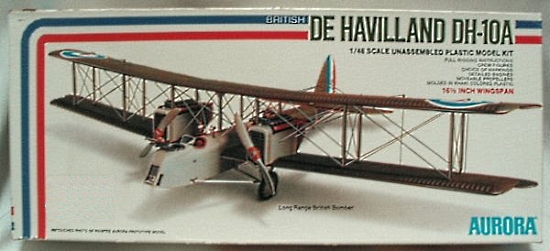Review By Fred Boucher and kit history by Alan Bussie Google+ profile
Introduction
Aurora released their big, 16½ inch(41.91 cm) wingspan de Havilland DH10 Amiens IIIA model in 1958 as the “De Haviland DH-10 Bomber.” It was the 13th of 20 1/48 scale kits in their “Famous Fighters” of World War I series. The DH10 was Aurora’s Triple Entente / Allied ‘monster’ kit, with Germany’s Gotha being the ‘monster’ representing the Central Powers. This model represents the Amiens IIIA variant.
DH-10 IIIA (courtesty airwar.ru)
The actual DH10 was built in five variations:
Amiens I- Prototype powered by two pusher Puma engines.
Amiens II- Prototype powered by two tractor Rolls Royce Eagle engines.
Amiens III- Main production variant, powered by Liberty 12 engines mounted midway between wings, 221 built.
Amiens IIIA- Modified Mark III with engines directly attached to lower wings, 32 built, also known as the DH.10A
Amiens IIIC- Version powered by Rolls Royce Eagle engines in case of shortages of Liberty engines, 5 built, also known as the DH.10C. *
Kit History
The early success of Aurora’s 1/48 WWI series from 1956 gave them the clear lead for this field. Realizing a good thing, Aurora expanded the line rapidly, adding a few new kits each year. The first DH-10 issue features stunning Jo Kotula artwork and a copyright date of 1958. The original kit number was 125-198. It was issued in the typical “hardbox”; a thick cardboard box top and bottom with the glued lithograph “slick” holding the box top together. The logo first used is the Aurora Sunburst Oval with “Famous Fighters” in the border. These boxes were generally not shrink wrap or cello sealed. Usually Aurora placed two pieces of tape across the box bottom and two long sides as a ‘seal’. Inside, the main parts are molded in a beautiful high-gloss olive drab with the details in black. A ground wheel chock base and two ground crew are included. This issue is the most desirable kit for collectors and for those who do “Classic Builds” straight from the box with minimal painting.
#125-198
A variation of this kit exists with the “Parents Seal” logo and the same Aurora logo, hardbox, parts, plastic color and part number.
#125-198 with Parents Magazine Seal at middle upper left
It appears that while most of Aurora WWI series remained in production through the 1960s, the DH-10 and Gotha did not. For example, neither were listed in the 1965 annual catalog. The next boxed appearance was 1972. The K&B “Collectors Series” issue is perhaps the most deluxe of all issues and sports beautiful artwork by John Amendola. The part number is 1125-300 and features the revised molds and decals for two different aircraft as well as the first rigging diagram. This kit also includes the “Battle Terrain” base, which is a vacuformed diorama display for the aircraft and ground crew. The kit is usually found molded in tan and black plastic.
#1125-300
Additionally, there is an Aurora Canada issue. which was similar to the K&B issue in appearance and issue date. The box is identical except for the origin, a part number of #1125 or 1125-350, and the Aurora logo instead of K&B. Inside, the kit parts are usually identical to the K&B issue with tan and black plastic and the vacuform base.
The DH-10 appeared in the USA catalog in 1977, but we know that kit number 786 is dated 1976. To emphasize accuracy, Aurora used a photograph of the built model on the box top. This and the K&B kit are more in demand for accurate building but they are collected also. This is the improved molds kit reviewed in this article, but without the Terrain Base and two ground crew. This issue is in a “softbox”, a thin, two-piece cardboard box with the printing directly on the box. There is no lithographed slick.
#786, circa 1976
To date there have been no further reissues of this kit. It is rumored that this kit was damaged in the famous train accident. When Aurora closed out the model business, Monogram purchased the molds. Reportedly, the molds were put on a Chicago-bound train and the train derailed. The damage to the molds was extensive and many were destroyed or damaged beyond repair. The DH-10 is suspected to be among those.
Opening The Hanger Doors
This review is of the 1976 improved molds 700-series “photo” box issue.
Inside are instructions, decals, two clear pieces and 68 parts injection molded in black and olive. Some of the parts are molded impressively thin. One piece is an identification button bearing “DeHavilland DeH-10A Great Britain.” Molding is good with some flash, mold seam lines, a few sink holes, and era-typical visible ejector marks. Too many are on the top of the bottom wings, wing struts, and fuselage halves. Struts and trailing edges are too thick.
Plastic Parts Overview Fuselage Halves Nacelles Tail Planes Clear Parts
(click any photo to enlarge)
Figure detail is soft as though one passed them over a flame to round off the edges. The pilot has a small sink hole while the others have ejector circles and flash. The pilot is seated, a gunner is manning his machine gun and the other is high-fiving something. In this issue, Aurora did not include a base to pose the model and figures upon.
Crew Figures Crew Closeup
(click any photo to enlarge)
Test fitting reveals a fair fit. Filler will be necessary along the fuselage, empennage, nacelles and wings. Where the cabanes and interstruts mate into the airframe will require care because each is a separate and probably delicate strut.
Happily all molded insignia and data were removed when this kit was injected. Expect raise insignia detail if you find the 1958 – 1960s model; removing it is a horrible exercise at best even on flat surfaces!
Accuracy
Aurora was one of, if not the first, to make models to a standard size. This quarter-scale model measures out very close. With a top wing span of 66 feet their Amiens IIIA is too wide by 6 inches. I measured the fuselage from nose to rudder at 40 feet 3 inches, about 8 inches too long. I have no practical way of judging the model contours although it looks a lot like a DH10 to me.
DH-10 Walk-around
Surface detail includes raised lines representing access hatches, control horns, and control wire ports. There are several separate small parts for control pulleys, generators and other details. Aurora textured the fabric areas of the airframe components. It does not resemble woven fabric as much as a gritty non-slip material. There are many ejector circles. Curiously the upper wings did not receive the texturing, but have unsightly leading edge ridges presumably for wing ribbing.
Horizontal Stabilizer Wing Closeup Updated Engraving Fuselage Close-up
(click any photo to enlarge)
A partial pair of 400 hp Liberty 12A V-12 water-cooled engines are comprised of five parts, or ten including the nacelles and radiator and propeller.
Engines, etc. Propellors Radiators, etc
(click any photo to enlarge)
Two .303 in. (7.7 mm) Lewis machine guns are recognizable but clumsy and marred with ejector circles. Both have Scarff rings to mount on.
Machine Guns (click to enlarge)
The cockpit is almost nothing: floor, seat and a slightly detailed instrument panel. The pilot blocks most of it. There is nothing in the gunner’s holes.
Instructions, Paint, Decals and Rigging Guide
Aurora did a good job with the instructions, with the large sheet segmented into four assembly sequences for the 70 parts. Line art illustrates everything with all parts identified. Finally, Aurora includes a basic diagram for rigging the beast. The painting guide coveres two different aircraft utilizing seven colors.
Instructions, rigging and painting guides (click any photo to enlarge)
Decals include six roundels with separate red dots, rudder stripes, and serial numbers. There are markings for two different aircraft.
Kit Decals (click photo to enlarge)
Chocks Out!
Another great trip to memory-drome! Even today this kit is sought for building and collecting. Some collectors enjoy building the kit straight-from-the-box as they did in the 1950s and 1960s. The first issue with it’s attractive high-gloss plastic is perfect for this. Despite its ejector circles this model is very appealing and impressive. It shouldn’t take much effort to upgrade it if you wish. Some of the parts are molded impressively thin. Those who wish to build it to current standards will find it ripe for detailing.
Highs: Happily all molded insignia and data were removed when this 1976-issue kit was injected.
Lows: Some flash, mold seam lines, a few sink holes and visible ejector marks. Unconvincing fabric texture and detail.
Verdict: No doubt you can make a respectable model with it, as evidenced by the many examples online. I would even buy and build one for more than just nostalgia.
Direct from the Instructions Sheet (with Aurora spelling and punctuation)
“History of the de Havilland DH10 Amiens III bomber”
The original de Havilland DH-10, a twin engine bomber, was based on the configuration of the D.G.3, It was powered by two 230 h.p. Sidley Puma engines installed as pushers— {the second prototype was changed to two Rolls-Royce Eagle VIII engines installed as tractors). Designed as a three seater, the pilot sat in line with the leading edge of the lower wings. The gunners’ cockpits were in the nose and behind the wings, each equipped with two mountings for Lewis guns. Both gunners had dual control. The DH-10A made its first flight on March 4th, 1918.
Subsequently, because of many short-comings, numerous changes and versions were made during the next eight years. The nacelles were modified to house two high-compression American Liberty engines that delivered 405 h.p, at 1,650 r.p.m. Because of production problems of the Liberty engines, later models were again fitted with the Rolls-Royce Eagle.
Due to many difficulties, late production, and the advent of the Armistice the DH-10A saw slight service in World War I. Only eight planes were delivered to the R.A.F. After the Armistice it was used on a regular air-mail service to the British occupation forces in Germany. The DH-10A was, also, the first aircraft to carry air-mail by night-flying non-stop to Cologne form England.
In 1919 DH-10As were taken to India and assigned to the No. 60 Squardon. They were initially used for bombing on the frontier of Waziristan. The extreme heat of this locale affected their performance which led to them being fitted with larger radiators for eastern and middle-east service.
The DH-10A had an empty weight of 5,750 Lbs.; loaded, 9,000 Lbs. including 954 Lbs. military load; crew 540 Lbs.; fuel and oil 1,756 tbs. Loaded, its top speed was 126 m.p.h. at 6,500 feet. At 15,000 feet it dropped to 112 m.p.h. Its climb from take-off to 15,000 feet took 24 minutes and 30 seconds. Endurance was 5½ hours and a service ceiling of 17,500 feet.
_______
Sources
1. Royal Air Force Museum. de Havilland DH10 Amiens. [Web.] n.d.
*. Wikipedia. Airco DH.10. [Web.] 23 July 2013.
https://www.rafmuseum.org.uk/research/archive-exhibitions/not-quite-extinct/de-havilland-dh10-amiens/what-do-we-have.aspx
























